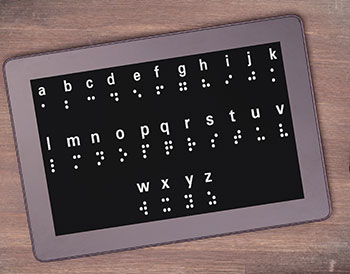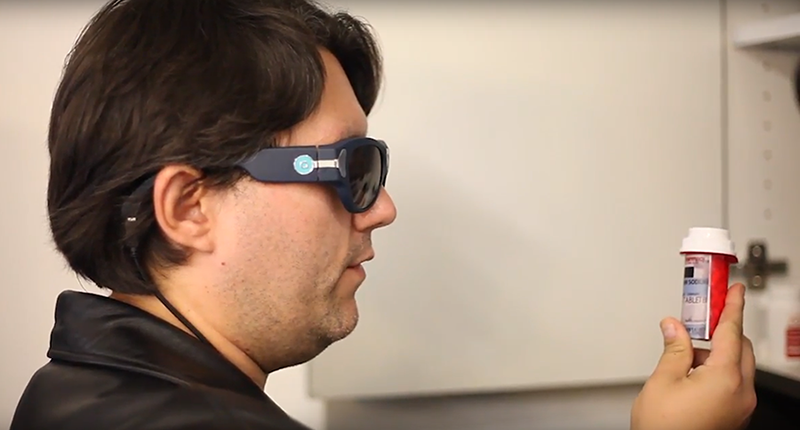Discover Cutting-edge Devices Made for the Aesthetically Impaired
The growth of innovative devices for the aesthetically damaged represents a considerable improvement in accessibility and self-reliance. Technologies such as smart glasses with AI capacities and mobile applications designed to supply acoustic summaries are improving day-to-day experiences for individuals. In addition, wearable devices that utilize haptic feedback improve environmental awareness, while contemporary Braille advancements offer brand-new methods to involve with message. As these tools continue to evolve, their influence on the lives of those with visual impairments increases important questions about the future of inclusivity and freedom in different aspects of life. What exists in advance in this technological landscape?
Smart Glasses for Navigation

Smart glasses designed for navigating are changing the way aesthetically damaged individuals interact with their setting. These innovative tools make use of a mix of cam technology, expert system, and acoustic comments to offer real-time details regarding environments. By using challenge detection systems, wise glasses can alert customers to potential hazards, allowing safer mobility in both unknown and familiar settings.
The integration of GPS innovation better improves navigating capabilities, enabling users to receive auditory directions as they relocate. This hands-free approach not only promotes self-reliance however additionally empowers visually damaged individuals to navigate city landscapes with enhanced confidence. In addition, numerous smart glasses are equipped with functions that recognize landmarks and road signs, giving contextual information that improves the individual experience.
Moreover, the development of these gadgets is constantly advancing, with companies working to enhance the precision of object acknowledgment and broaden the variety of navigational features. As clever glasses come to be much more inexpensive and obtainable, they hold the potential to considerably change life for aesthetically impaired users. Ultimately, these innovative tools stand for a critical action towards inclusivity, offering boosted movement and a better sense of autonomy for individuals navigating the globe around them.

Mobile Apps for Daily Living
Exactly how can mobile applications boost the lives of aesthetically impaired individuals? Mobile applications are reinventing the way visually damaged customers navigate their atmospheres, handle day-to-day jobs, and access info. These applications give necessary support via numerous capabilities, fostering independence and improving lifestyle.
Numerous ingenious mobile apps are developed particularly for daily living. For circumstances, applications like Be My Eyes attach visually impaired individuals with sighted volunteers using video telephone calls, enabling them to receive real-time support with tasks such as reading tags or navigating strange areas. Seeing AI, created by Microsoft, uses fabricated knowledge to explain surroundings, reviewed text, and identify objects, effectively changing a smartphone into an effective device for everyday support.
In addition, navigating applications customized for the visually impaired, such as Aira and BlindSquare, use audio-based instructions and ecological information, allowing individuals to traverse their surroundings securely and confidently. Beyond navigation and prompt help, mobile apps also support organization and job monitoring, with functions that help customers set suggestions, develop order of business, and track consultations. In recap, mobile applications work as vital resources, equipping visually damaged individuals to lead more independent and satisfying lives.
Wearable Technologies for Support
Empowerment with technology is increasingly evident in the world of wearable tools developed to help visually impaired individuals. These cutting-edge tools integrate effortlessly right into life, boosting navigation and supplying crucial responses to individuals. As an example, smart glasses geared up with video cameras can identify faces and review message out loud, enabling users to connect even more confidently in specialist and social setups.
One more remarkable advancement is the use of haptic comments systems in wearable gadgets. These systems use resonances or other tactile signals to communicate details concerning the individual's atmosphere, such as barriers or changes in terrain, improving mobility tortoise eyeglasses and safety. Wearable technologies likewise include wristbands that attach to smart devices, informing customers to alerts through subtle vibrations, thus improving connection without dependence on visual cues.
As these innovations proceed to evolve, they are not only improving independence for aesthetically damaged people but likewise promoting a greater feeling of addition in culture. By linking the space in between difficulties encountered in day-to-day living and the possibility for autonomy, wearable innovations work as critical devices in the pursuit for equality and empowerment for those with aesthetic disabilities.
Audio Description Tools
Sound summary tools play an important function in boosting accessibility for aesthetically impaired individuals, supplying them with the capability to engage with visual media. Wearable technology for low vision. These tools use narrated summaries of essential visual aspects in films, television shows, and live efficiencies, guaranteeing that users can completely comprehend the context and emotions communicated with visuals
Sound summary can be integrated into various systems, including streaming solutions, movie theater testings, and live cinema. Many popular streaming services currently consist of audio description as an accessibility feature, enabling visitors to pick it easily. In enhancement to mainstream media, specialized apps likewise exist, providing audio descriptions for art exhibits, museums, and other cultural events.
The efficiency of audio summary pivots on the skill of the narrators, who need to convey visual details succinctly without interfering with the initial audio. Advancements in this area are also leading the way for even more personalized experiences, where customers can adjust the degree of information and pacing according to their choices.
Braille Innovations and Tools
Braille tools and innovations have actually considerably changed the means aesthetically impaired individuals engage with text and details. Modern developments have actually led to the development of functional tools that enhance literacy and self-reliance among users.
Furthermore, portable Braille notetakers incorporate standard Braille input with modern performances, promoting note-taking, scheduling, and record editing on the move. OCR devices for the blind. These portable gadgets often include text-to-speech capacities, connecting the space in between Braille her latest blog and auditory information
Furthermore, innovative Braille printers have emerged, permitting customers to generate Braille labels, files, and instructional products effectively. This availability cultivates higher participation in expert and academic environments, inevitably promoting inclusivity.
In addition, research right into smart Braille innovations proceeds to increase. Tools that incorporate artificial intelligence are being explored to give real-time navigation aid and contextual information, enhancing the customer experience in varied setups. Overall, these technologies show a dedication to encouraging visually impaired people with innovation, guaranteeing they can conveniently gain access to and involve with the world around them.

Conclusion
The innovation cool reading glasses of ingenious devices for the aesthetically damaged significantly enhances independence and quality of life. These modern technologies not just foster greater incorporation but likewise advertise autonomy in daily activities, ultimately contributing to a more obtainable and fair culture for aesthetically damaged people.
As clever glasses become more budget-friendly and accessible, they hold the potential to considerably change daily life for visually impaired individuals. Mobile apps are transforming the method visually impaired customers navigate their atmospheres, take care of daily tasks, and gain access to information. Apps like Be My Eyes connect aesthetically damaged individuals with sighted volunteers via video clip telephone calls, allowing them to receive real-time aid with tasks such as checking out labels or browsing unfamiliar areas.In addition, navigating applications customized for the aesthetically damaged, such as Aira and BlindSquare, provide audio-based instructions and ecological information, allowing individuals to traverse their surroundings safely and with confidence.The innovation of innovative devices for the aesthetically damaged dramatically enhances independence and high quality of life.